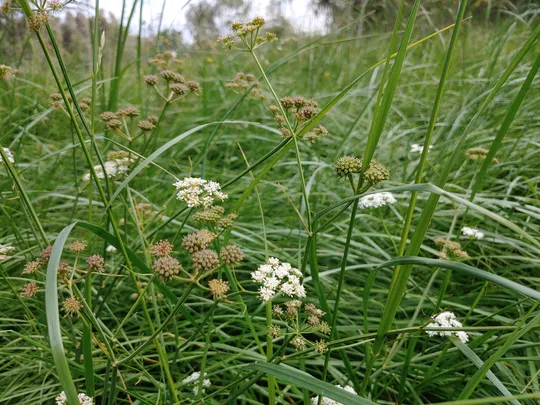Tubular Water-dropwort, Fistulous Dropwort
Oenanthe fistulosa
Oenanthe fistulosa once grew in
the Sharon and Hula Valley regions. It now grows now only in the Golan and at
the foot of Mount Hermon: it was collected in the Sharon from Gan Shmu'el in
1926 and from near Hadera in 1927-1931. Since then, despite the efforts of the
rare species survey in 1993-1994, it has not been found there. In the Hula
Valley, it was collected near Kibbutz Amir in 1941 and from 2 spots in the Hula
Marsh, in 1955, just before it was drained. In the Golan, it was collected in
the 1980s mainly from the central Golan: Wadi Orvim, Daliot Reservoir, Zavitan
Stream, Daliot Stream, Bne Israel (Hispin) Reservoir. It was also collected a
single time on Mount Keta near Wadi Nimrod in 1983 at an altitude of 1070
meters.
Wetlands, seasonal pools and seasonal sills. Grows in
the Golan Heights on a broad range of altitudes from 290 to 1070 meters.
For the genus, see Oenanthe
pimpinelloides.
In Israel there are four species of Oenanthe,
all of which grow in almost the same habitat., Their distribution areas in
Israel are also very similar – all the species grow (or grew in the past) both in wetlands on the coastal plain and in
wetlands on the Golan Heights. Most of the species are found in seasonal pools
as well as in seasonal waterways. This is a unique case where perennial species
belonging to the same genus are sympatrically distributed in the same habitat.
This assertion may change if it turns out that some them in fact belong to the same
taxon.
Of the four species, only O. fistulosa
has a spherical capitulum-like inflorescence, while in the other species the
inflorescence is umbel-like and flat. O. silaifolia grows in shallow
streams in the Golan, and is almost extinct in western Israel. O. pimpinelloides
is
very close to O. silaifolia, but the umbel bracteoles slant
downwards.
·
Oenanthe fistulosa now grows on six sites limited to the Golan (one at the foot of
Mount Hermon). The populations that grew fifty years or more ago in the Sharon
and the Hula Valley are long extinct.
·
The
destruction of the Coastal Plain sites is a result of the degradation of
aquatic habitats in the region. The disappearance of O. fistulosa from the
Hula Valley suggests that in addition to the decrease in
the number of aquatic habitats, the water quality of the remaining habitats has
also gotten worse and is no longer suitable for O. fistulosa.
A thorough field survey, focusing on the Golan, should
be conducted to map the distribution of all four Oenanthe species. The survey should be complemented by taxonomic research on
the Oenanthe species in Israel and a study of their habitats. Two plots should be demarcated in the northern (Yafori
Valley, Mount Keta) and in the central (Mesil Asnia, Enot Peham) Golan, and
they should be monitored and the taxonomy and demographics of the Oenanthe
species growing in Israel should be studied.
Oenanthe fistulosa is widely
distributed across Europe and the Mediterranean Basin: it grows in all the Western
European countries including Scandinavia, the Maghreb countries, and all the countries
in the northern Mediterranean from Spain to the Balkans and the Black Sea
countries. In the Middle East O. fistulosa
grows in northern and northwestern Turkey, in northwest Iran, in the coastal
region of Syria-Lebanon and in Israel. It is absent from Jordan and Iraq.
O. fistulosa is a perennial northern plant of seasonal wetlands. Israel is the southern limit of its global distribution. The plant became extinct on the coastal plain following the degradation of the wetlands in the region. It survived only in the Golan and at a single site at the foot of Mount Hermon.
Current Occupancy Map
| 1000 squre meter pixel | 5000 squre meter pixel | 10000 squre meter pixel | |
|---|---|---|---|
| number of observations | 0 | 0 | 0 |
| in total pixels | 0 | 0 | 0 |
| Family | Apiaceae |
| Classification | On the endangered species list |
| Ecosystem | Mediterranean humid |
| Chorotype | Western Euro – Siberian, Mediterranean |
| Conservation Site | Mesil Asnia in Golan |
| Rarity |
1
3
6
|
|---|---|
| Vulnerability |
0
4
4
|
| Attractiveness |
0
0
4
|
| Endemism |
0
0
4
|
| Red number |
1
4.2
10
|
| Peripherality | N |
| IUCN category | DD EW EX LC CR EN VU NT |
| Threat Definition according to the red book | Endangered |
 Based on:
Based on:






